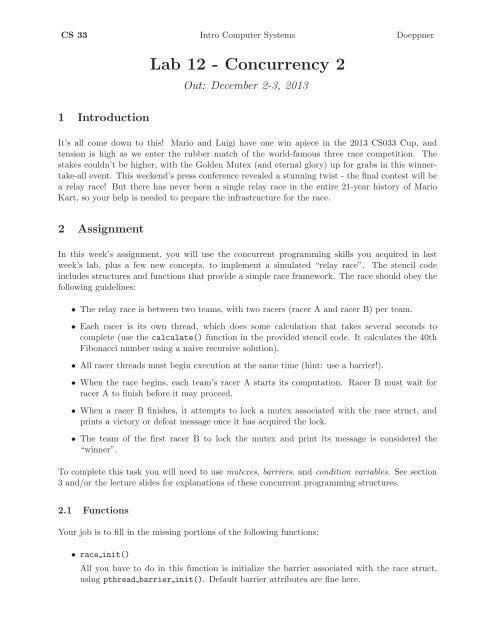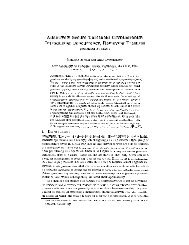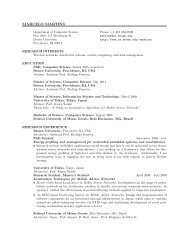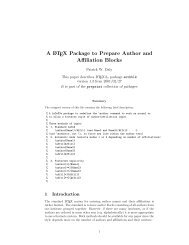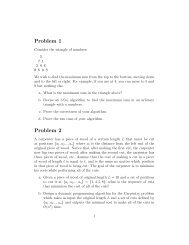Lab 12 - Concurrency 2
Lab 12 - Concurrency 2
Lab 12 - Concurrency 2
Create successful ePaper yourself
Turn your PDF publications into a flip-book with our unique Google optimized e-Paper software.
CS 33 Intro Computer Systems Doeppner<br />
<strong>Lab</strong> <strong>12</strong> - <strong>Concurrency</strong> 2<br />
Out: December 2-3, 2013<br />
1 Introduction<br />
It’s all come down to this! Mario and Luigi have one win apiece in the 2013 CS033 Cup, and<br />
tension is high as we enter the rubber match of the world-famous three race competition. The<br />
stakes couldn’t be higher, with the Golden Mutex (and eternal glory) up for grabs in this winnertake-all<br />
event. This weekend’s press conference revealed a stunning twist - the final contest will be<br />
a relay race! But there has never been a single relay race in the entire 21-year history of Mario<br />
Kart, so your help is needed to prepare the infrastructure for the race.<br />
2 Assignment<br />
In this week’s assignment, you will use the concurrent programming skills you acquired in last<br />
week’s lab, plus a few new concepts, to implement a simulated “relay race”. The stencil code<br />
includes structures and functions that provide a simple race framework. The race should obey the<br />
following guidelines:<br />
• The relay race is between two teams, with two racers (racer A and racer B) per team.<br />
• Each racer is its own thread, which does some calculation that takes several seconds to<br />
complete (use the calculate() function in the provided stencil code. It calculates the 40th<br />
Fibonacci number using a naive recursive solution).<br />
• All racer threads must begin execution at the same time (hint: use a barrier!).<br />
• When the race begins, each team’s racer A starts its computation. Racer B must wait for<br />
racer A to finish before it may proceed.<br />
• When a racer B finishes, it attempts to lock a mutex associated with the race struct, and<br />
prints a victory or defeat message once it has acquired the lock.<br />
• The team of the first racer B to lock the mutex and print its message is considered the<br />
“winner”.<br />
To complete this task you will need to use mutexes, barriers, and condition variables. See section<br />
3 and/or the lecture slides for explanations of these concurrent programming structures.<br />
2.1 Functions<br />
Your job is to fill in the missing portions of the following functions:<br />
• race init()<br />
All you have to do in this function is initialize the barrier associated with the race struct,<br />
using pthread barrier init(). Default barrier attributes are fine here.
CS 33 <strong>Lab</strong> <strong>12</strong> - <strong>Concurrency</strong> 2 December 2-3, 2013<br />
• create racer()<br />
This function should initialize the mutex and condition variable associated with a racer. This<br />
can be accomplished using pthread mutex init() and pthread cond init(). See the man<br />
pages for more detailed explanations of these functions.<br />
• run racer a()<br />
This is the function that represents a racer A. Three things should happen in this function:<br />
1) Wait at the barrier associated with the race struct to ensure that it does not begin<br />
executing until all four racer threads are ready.<br />
2) Perform its racer’s computation by calling calculate().<br />
3) Set its racer’s finished value to 1 and signal its condition variable. This informs the<br />
racer B thread that it is all set to proceed.<br />
• run racer b()<br />
This is the function that represents a racer B. Five things should happen in this function:<br />
1) Wait at the barrier associated with the race struct to ensure that the race does not begin<br />
until all four racer threads are ready.<br />
2) Wait for the corresponding racer A thread to finish.<br />
3) Inform the user that racer A has finished by calling handoff().<br />
4) Perform the racer’s own computation by calling calculate().<br />
5) Lock the race mutex, call announce(), and then unlock the race mutex.<br />
• start race()<br />
In this function you should create the four racer threads using pthread create(), and then<br />
wait for them all to complete by calling pthread join() on each thread.<br />
As in last week’s lab, the functions you will be running in separate threads require more than<br />
one argument. As such, you will once again need to wrap the arguments for each function in<br />
a struct before you pass them to pthread create(). The struct you should use is args t,<br />
which is provided in the stencil code.<br />
For more information, see the man pages for pthread create() and pthread join().<br />
3 Concurrent Programming Concepts<br />
3.1 Barriers<br />
A barrier is useful structure in concurrent programming that allows for synchronization of an<br />
arbitrary number of threads.<br />
• int pthread_barrier_init(pthread_barrier_t *barrier,<br />
const pthread_barrierattr_t *attr, unsigned count)<br />
• int pthread_barrier_destroy(pthread_barrier_t *barrier)<br />
2
CS 33 <strong>Lab</strong> <strong>12</strong> - <strong>Concurrency</strong> 2 December 2-3, 2013<br />
• int pthread_barrier_wait(pthread_barrier_t *barrier)<br />
When creating a barrier, the user specifies some number (count) of threads that must wait at the<br />
barrier before any of the waiting threads may continue. Once count threads are waiting at the<br />
barrier, all of those threads resume execution.<br />
Barriers are critical to ensure that the relay race we are trying to implement is fair - the order in<br />
which racer threads are created should not impact the race’s outcome! You should create a barrier<br />
that prevents any racer thread from beginning execution until all the racers have been created.<br />
To initialize a barrier, you can use the pthread barrier init() function. Threads which must<br />
wait at the barrier (i.e. racer functions) should call pthread barrier wait() on the barrier. As<br />
always, see the man pages for more information on these functions. Be sure to clean up your barrier<br />
using pthread barrier destroy() once it is no longer needed.<br />
3.2 Mutexes<br />
A mutex (short for Mutual Exclusion) is a “lock” that grants a thread exclusive access to a<br />
particular region of code or data. Only one thread can lock a mutex at any given time. You should<br />
already be familiar with using mutexes from last week’s lab.<br />
For this lab, you will use a mutex to ensure that only one team can win the race. Additionally, you<br />
will need to use mutexes in conjunction with condition variables, as outlined below.<br />
3.3 Condition Variables<br />
Like barriers, condition variables are an important concurrent programming structure that allow<br />
for the synchronization of multiple threads. The mechanism for synchronization is quite different,<br />
however: as the name suggests, condition variables synchronize threads based on the state of some<br />
condition.<br />
Sometimes a thread must not proceed until a particular condition is satisfied. In situations like<br />
this, the thread waits for the condition, putting itself to sleep until it has been signaled that the<br />
condition has become true. If another thread updates this condition, it should signal the sleeping<br />
threads, causing them to resume execution. This process allows threads to avoid continuously<br />
polling the condition.<br />
• int pthread_cond_init(pthread_cond_t *cond, pthread_condattr_t *cond_attr)<br />
• int pthread_cond_broadcast(pthread_cond_t *cond)<br />
• int pthread_cond_wait(pthread_cond_t *cond, pthread_mutex_t *mutex)<br />
• int pthread_cond_destroy(pthread_cond_t *cond)<br />
The concepts behind condition variables have a nice mapping to C programming, with the addition<br />
of a mutex. This mutex must be used to lock data or code associated with the condition of interest.<br />
The mutex must be locked when pthread cond wait() is called. When a thread calls this function,<br />
the thread is put to sleep and the mutex is unlocked. When a thread wakes up from waiting, it<br />
3
CS 33 <strong>Lab</strong> <strong>12</strong> - <strong>Concurrency</strong> 2 December 2-3, 2013<br />
re-locks the mutex, so be sure to unlock that mutex once it is no longer needed. Signaling is a bit<br />
easier - all a thread needs to do to signal a condition variable is call pthread cond broadcast(),<br />
which signals all threads waiting on the indicated condition variable.<br />
In this lab, you will use condition variables to ensure that the “relay” part of your race is correctly<br />
implemented. A given team’s racer B thread must wait for its team’s racer A thread to finish<br />
calculating before it may begin its own calculation.<br />
For a more in-depth explanation of condition variables, see slide XXXI-10 in the lecture slides on<br />
the course website.<br />
4 Testing<br />
To test your program, run ./race (built by the provided Makefile) several times. You should observe<br />
the following behavior:<br />
• After a few seconds, the string “Racer A of team<br />
has finished!” will be printed twice.<br />
• After a few more seconds, the strings “Team has locked the Golden Mutex and won the<br />
race!” and “Team has come in second place, securing the Silver Mutex!” will be printed.<br />
Note that the order in which teams hand off and finish may (and should!) vary from run to run.<br />
This is not an error, but an intentionally produced race condition.<br />
4.1 Debugging<br />
Concurrent programming occasionally leads to a common class of bugs called deadlocks. To solve<br />
deadlocks, it is often helpful to look at the state of threads while they are stuck to identify what<br />
they are waiting for. gdb offers a set of helpful debugging tools for multithreaded programs that<br />
allows just that. To start gdb with your program, type<br />
gdb ./race<br />
Once gdb is started up, use the run command followed by the program arguments to run your code.<br />
While your program is running, it is possible to interrupt and pause it so you may inspect the state<br />
of each thread. You may interrupt gdb using CTRL-Z.<br />
From here, you may print a list of threads by typing info threads. This command enumerates<br />
the threads. You will see a * next to the current thread you are inspecting. To inspect a different<br />
thread, type thread NUMBER where NUMBER corresponds to the numbers in the list you printed.<br />
You will find it is most helpful to print a backtrace with the bt command. This will print the<br />
functions the current thread is executing.<br />
Use this information to discern where any deadlocks are coming from and how to fix your code.<br />
4
CS 33 <strong>Lab</strong> <strong>12</strong> - <strong>Concurrency</strong> 2 December 2-3, 2013<br />
5 Getting Checked Off<br />
Once you’ve completed the lab, call a TA over and have them inspect your work. If you do not<br />
complete the lab during your lab session, you can get credit for it by completing it on your own<br />
time and bringing it to TA hours. Remember to read the course missive for information about<br />
course requirements and policies regarding labs and assignments.<br />
5


